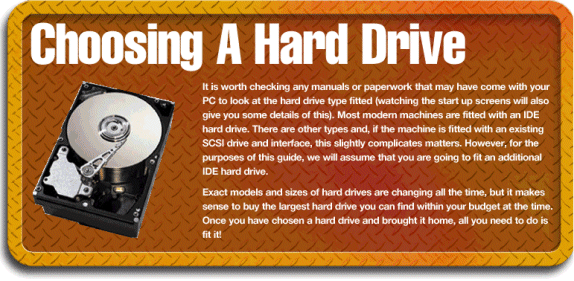| to take the make and model number of the drive from the
sticker on it, and find a way to go online to the Internet. Type the model number in on any search
engine along with the words “jumper links”. This will most probably return any number of
sites that will give you the jumper information you need for your drive. Having reconfigured your original hard drive, you need to look at the information that came with your new hard drive, (which was probably supplied with default settings identifying it as a master drive), and reconfigure it as a slave. You may now fit both hard drives back in the case and fit the data and power cables to them. PC cases always have several spare power leads so you should be able to find and route a spare connector to your new drive quite easily. Some data cables are already fitted with a second hard drive connector, and the cable provided with your new hard drive may well have this extra connector fitted. If your cables do not have the required extra data connector, you may do one of two things, depending on your system configuration. You may choose to purchase a new IDE data lead with the extra connector (such as the Maplin DG40T), which is the only possible option with older PCs with only a single IDE channel, unless you buy an extra IDE interface card. Alternatively, as most modern PCs are fitted with two IDE channels, you may simply use the extra lead provided with your hard drive to connect the new drive to IDE channel 2. |
| There are various pieces of software that will help you
set up and partition a new hard drive, and it is beyond the scope of this guide to go into them in
detail here. When you first power your PC up after fitting your new hard drive, you will need to hit the “Del” key when prompted in order to enter the BIOS configuration programme. The main menu should contain an item called “Auto detect hard drives” or something similar. Note that very old PC BIOS software did not have this option, but if your PC is this old, you should really consider a more radical upgrade or replacement of the entire unit. Selecting the auto detect option should rapidly result in a complex set of numbers being displayed. Check that the BIOS seems to have correctly identified the size of your original hard drive (which should have been identified first) and type “y” and return to accept the choice. If you have fitted your new hard drive as a slave to the original master, the BIOS should then detect it as a Primary Slave. Hit “y” and return to accept this setting. Otherwise, you may find the new drive as the Secondary Master. Do not expect your BIOS to see an IDE CD-Rom drive at this point. If either your master or slave drive did not auto-detect at this stage, you need to double check all jumper settings and data cable connections before continuing. If all seems correctly connected, there may just be some sort of compatibility problem between the different drives on your machine. Sometimes, hard drives of different makes don’t work happily together in a master/slave |

| Please note that if you do choose to do this, you should
set both drives to their “Master, no slave present” jumper configuration. IDE hard drives
are often fitted as either slaves to the main hard drive, or as Secondary Master drives on channel
2, so you may need to juggle drives and jumper settings around to find the best combination. Once the hard drives are securely mounted and wired into your system, reassemble the case and refit all peripheral connections. You are now ready to start the software reconfiguration to use your new hard drive. Please note at this stage that there can be some complications in using a very large hard drive, especially if you have a rather elderly motherboard in your PC. BIOS programmes in older PCs could not cope with very large hard drives unless they were partitioned into smaller and more manageable “virtual” drives. |
| configuration. Fortunately, with 2 IDE channels, you
usually have the option to swap things around, reset the jumpers and try the BIOS auto-detect again
until all drives appear. Once you have saved your BIOS settings and rebooted the machine, check that the IDE CD-Rom drivers load and initialise correctly, and that Windows starts up as usual. Double clicking the “My Computer” icon should now result in the new drive being displayed and ready to use. Please note that your CD-Rom drive letter may have shifted up because of the new drive being assigned the letter D, for example. It may be possible to reconfigure the CD-Rom drive letter using Control Panels “System” utilities, or you may opt to re-install any CD dependent software on your new hard drive, which will automatically reconfigure the settings for that programme. |